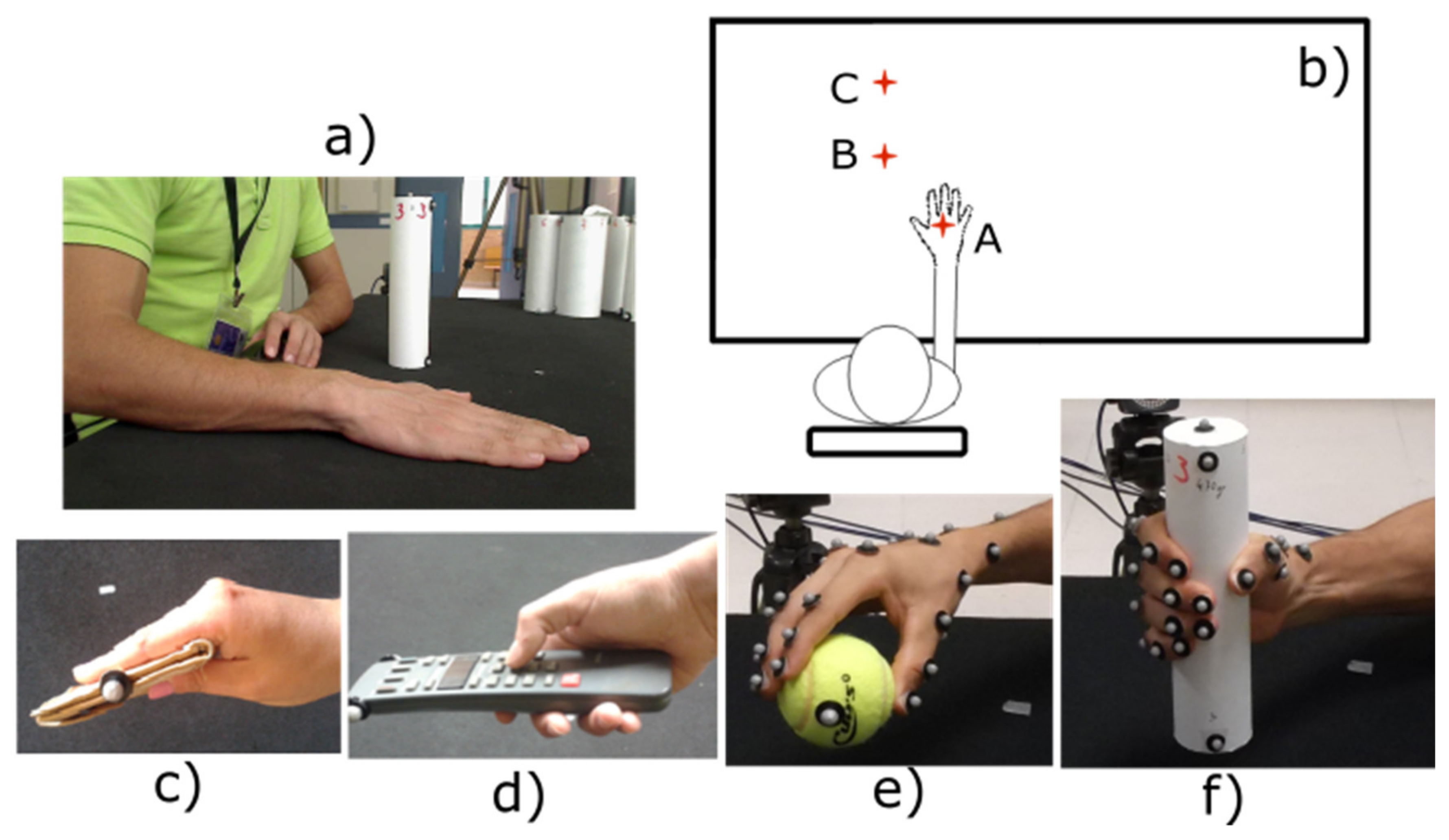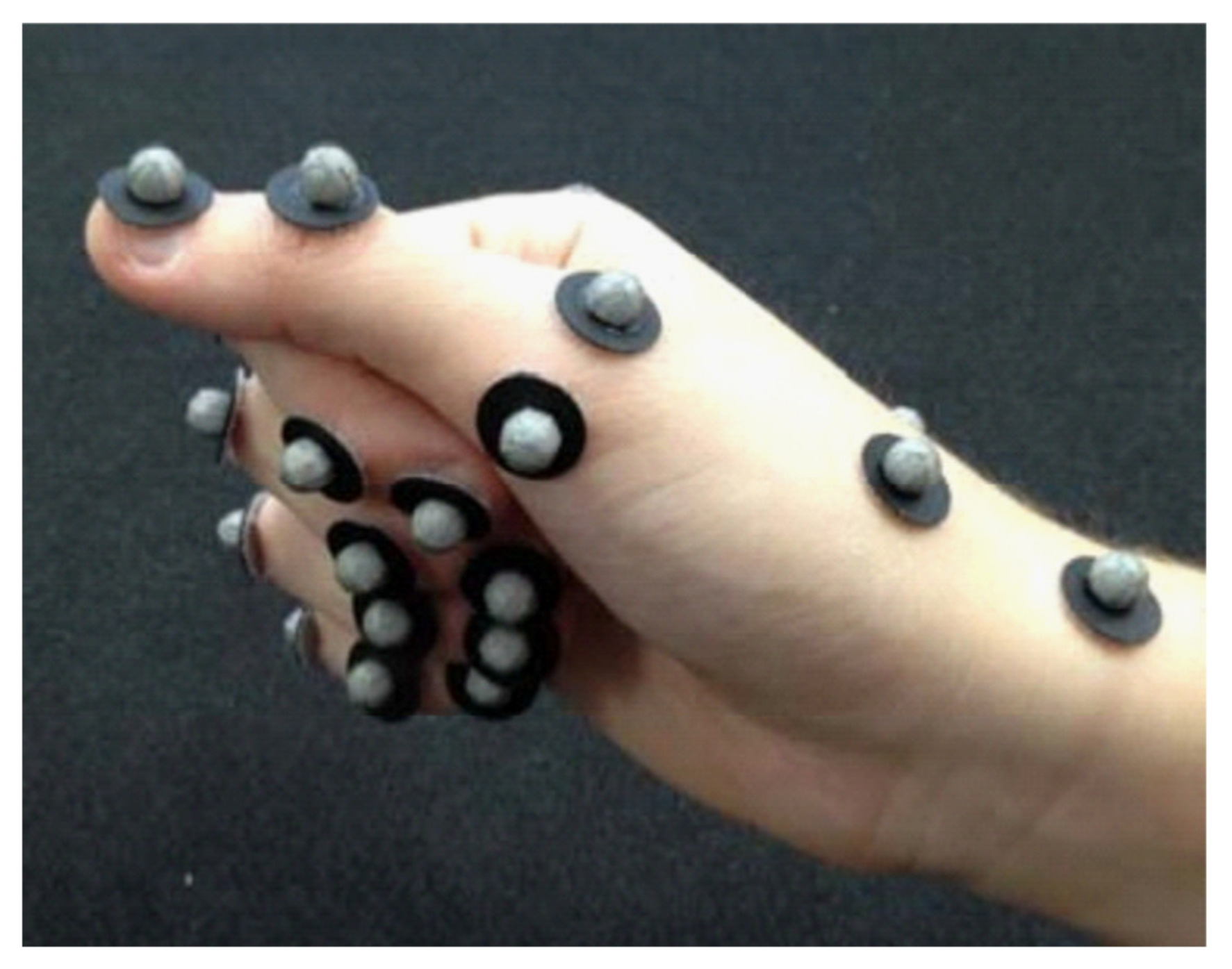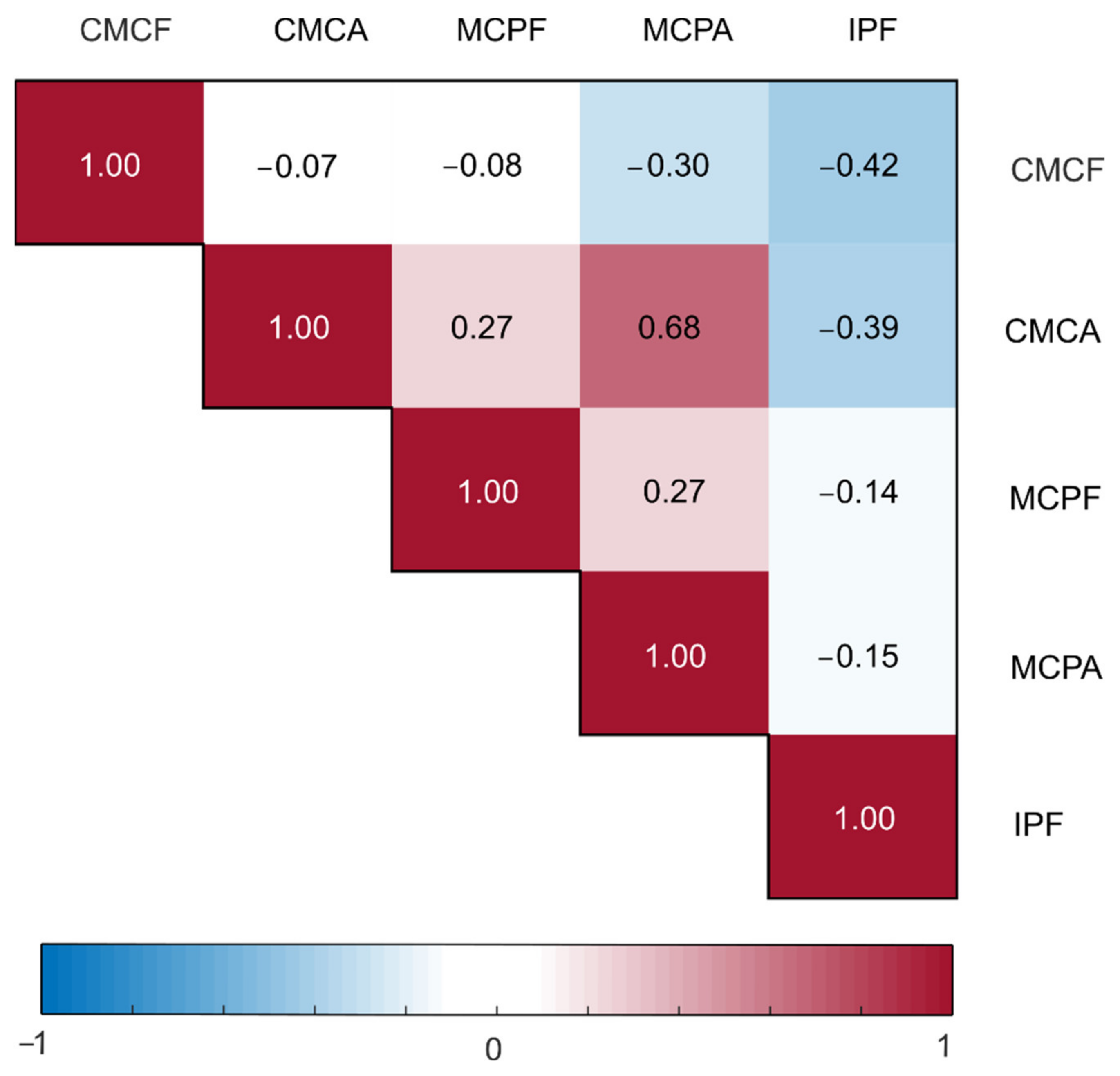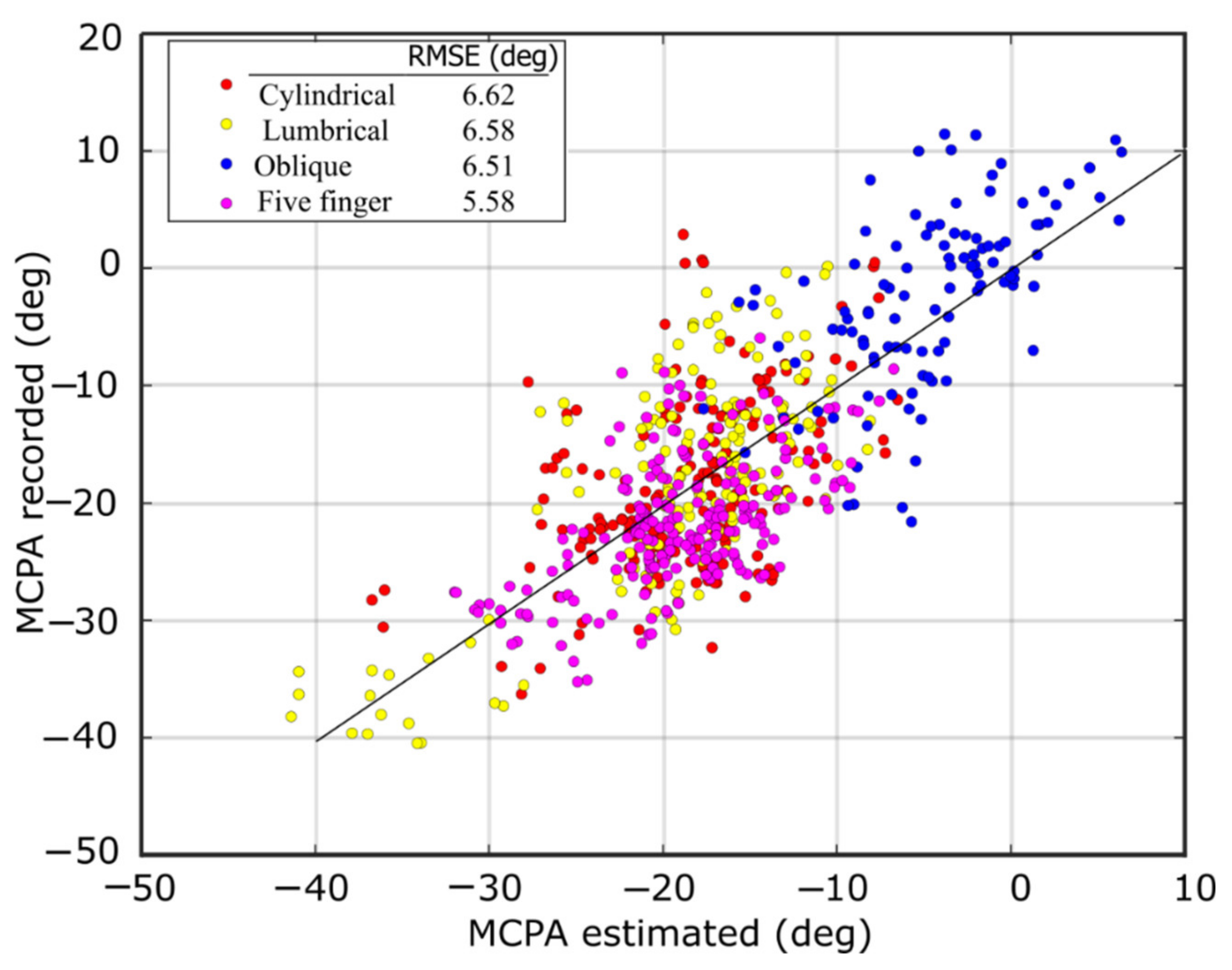Estimation of the Abduction/Adduction Movement of the Metacarpophalangeal Joint of the Thumb
Abstract
1. Introduction
2. Materials and Methods
2.1. Experiment A. Prediction Model
2.1.1. Experimental Procedure
2.1.2. Data Processing and Statistical Analysis
2.2. Experiment B. Evaluation of the Goodness of the Regression
2.2.1. Experimental Procedure
2.2.2. Data Processing and Statistical Analysis
3. Results
3.1. Experiment A. Prediction Model
3.2. Experiment B. Evaluation of the Goodness of the Regression
4. Discussion
Author Contributions
Funding
Institutional Review Board Statement
Informed Consent Statement
Data Availability Statement
Conflicts of Interest
References
- Cotugno, G.; Althoefer, K.; Nanayakkara, T. The Role of the Thumb: Study of Finger Motion in Grasping and Reachability Space in Human and Robotic Hands. IEEE Trans. Syst. Man Cybern. Syst. 2016, 47, 1061–1070. [Google Scholar] [CrossRef]
- Edmunds, J.O. Current concepts of the anatomy of the thumb trapeziometacarpal joint. J. Hand Surg. Am. 2011, 36, 170–182. [Google Scholar] [CrossRef] [PubMed]
- Kuroiwa, T.; Fujita, K.; Nimura, A.; Miyamoto, T.; Sasaki, T.; Okawa, A. A new method of measuring the thumb pronation and palmar abduction angles during opposition movement using a three-axis gyroscope. J. Orthop. Surg. Res. 2018, 13, 1–8. [Google Scholar] [CrossRef] [PubMed]
- Brand, P.W.; Hollister, A.M. Clinical Mechanics of the Hand, 3rd ed.; Mosby Publishing: St. Louis, MO, USA, 1999. [Google Scholar]
- Hollister, A.; Buford, W.L.; Myers, L.M.; Giurintano, D.J.; Novick, A. The axes of rotation of the thumb carpometacarpal joint. J. Orthop. Res. 1992, 10, 454–460. [Google Scholar] [CrossRef] [PubMed]
- Grinyagin, I.V.; Biryukova, E.V.; Maier, M.A. Kinematic and dynamic synergies of human precision-grip movements. J. Neurophysiol. 2005, 94, 2284–2294. [Google Scholar] [CrossRef] [PubMed]
- Nanayakkara, V.K.; Cotugno, G.; Vitzilaios, N.; Venetsanos, D.; Nanayakkara, T.; Sahinkaya, M.N. The Role of Morphology of the Thumb in Anthropomorphic Grasping: A Review. Front. Mech. Eng. 2017, 3, 5. [Google Scholar] [CrossRef]
- Li, Z.-M.; Tang, J. Coordination of thumb joints during opposition. J. Biomech. 2007, 40, 502–510. [Google Scholar] [CrossRef] [PubMed]
- Jarque-Bou, N.J.; Vergara, M.; Sancho-Bru, J.L.; Gracia-Ibáñez, V.; Roda-Sales, A. A calibrated database of kinematics and EMG of the forearm and hand during activities of daily living. Sci. Data 2019, 6, 270. [Google Scholar] [CrossRef] [PubMed]
- Della Santina, C.; Bianchi, M.; Averta, G.; Ciotti, S.; Arapi, V.; Fani, S.; Battaglia, E.; Catalano, M.G.; Santello, M.; Bicchi, A. Postural hand synergies during environmental constraint exploitation. Front. Neurorobot. 2017, 11, 41. [Google Scholar] [CrossRef] [PubMed]
- Ciotti, S.; Battaglia, E.; Carbonaro, N.; Bicchi, A.; Tognetti, A.; Bianchi, M. A synergy-based optimally designed sensing glove for functional grasp recognition. Sensors 2016, 16, 811. [Google Scholar] [CrossRef] [PubMed]
- Bullock, I.M.; Borras, J.; Dollar, A.M. Assessing assumptions in kinematic hand models: A review. In Proceedings of the IEEE RAS and EMBS International Conference on Biomedical Robotics and Biomechatronics, Rome, Italy, 24–27 June 2012; pp. 139–146. [Google Scholar]
- Cobos, S.; Ferre, M.; Aracil, R. Simplified human hand models based on grasping analysis. In Proceedings of the IEEE/RSJ 2010 International Conference on Intelligent Robots and Systems, Taipei, Taiwan, 18–22 October 2010. [Google Scholar]
- Vergara, M.; Sancho-Bru, J.L.; Gracia-Ibáñez, V.; Pérez-González, A. An introductory study of common grasps used by adults during performance of activities of daily living. J. Hand Ther. 2014, 27, 1–28. [Google Scholar] [CrossRef] [PubMed]
- Sancho-Bru, J.L.; Jarque-Bou, N.J.; Vergara, M.; Pérez-González, A.; Perez-Gonzalez, A. Validity of a simple videogrammetric method to measure the movement of all hand segments for clinical purposes. Proc. Inst. Mech. Eng. H 2014, 228, 182–189. [Google Scholar] [CrossRef] [PubMed]
- Hair, J.F.; Black, W.C., Jr.; Barry, J.B.; Anderson, E.R. Multivariate Data Analysis, 7th ed.; Prentice Hall: Hoboken, NJ, USA, 2009; ISBN 9780138132637. [Google Scholar]
- Gracia-Ibáñez, V.; Vergara, M.; Sancho-Bru, J.L.; Mora, M.C.; Piqueras, C. Functional range of motion of the hand joints in activities of the International Classification of Functioning, Disability and Health. J. Hand Ther. 2017, 30, 337–347. [Google Scholar] [CrossRef] [PubMed]
- Kapandji, I.A. The Physiology of the Joints, Volume 1: Upper Limb, 6th ed.; Churchill Livingstone/Elsevier: Amsterdam, The Netherlands, 2007. [Google Scholar]
- Cui, L.; Cupcic, U.; Dai, J.S. Kinematic mapping and calibration of the thumb motions for teleoperating a humanoid robot hand. In Proceedings of the ASME Design Engineering Technical Conference, Washington, DC, USA, 28–31 August 2011. [Google Scholar]








| Object | Weight (g) | Size (mm) | Subjects | Grasps |
|---|---|---|---|---|
| Heavy/thin cylinder | 470 | 35Ø | 9 | Lumbrical |
| 10 | Cylindrical | |||
| 10 | Five-finger | |||
| 9 | Oblique-palmar | |||
| Heavy/medium cylinder | 470 | 50Ø | 9 | Lumbrical |
| 10 | Cylindrical | |||
| 10 | Five-finger | |||
| Heavy/thick cylinder | 470 | 65Ø | 9 | Lumbrical |
| 10 | Cylindrical | |||
| 10 | Five-finger | |||
| Light/medium cylinder | 193 | 50Ø | 10 | Cylindrical |
| 10 | Five-finger | |||
| Sphere | 251 | 76 | 9 | Lumbrical |
| Wallet | 40.5 | 120 | 9 | Lumbrical |
| Remote controller | 74 | 450 × 180 | 9 | Oblique-palmar |
| Lighter | 100 | 510 × 330 | 9 | Oblique-palmar |
| Spoon | 33 | 40 × 230 | 9 | Oblique-palmar |
| Glass | 130 | 80Ø × 95 | 10 | Cylindrical |
| 10 | Five-finger | |||
| Tennis ball | 100 | 70 | 10 | Cylindrical |
| 10 | Five-finger | |||
| Marker pen | 30 | 10 × 145 | 10 | Five-finger |
| Book | 158 | 35 × 105 × 150 | 9 | Lumbrical |
| Coefficient | SE | tStat | p-Value | |
|---|---|---|---|---|
| Intercept | −5.825 | 0.428 | −13.622 | 0.000 |
| CMCA | 0.575 | 0.021 | 27.836 | 0.000 |
| CMCF × CMCA | 0.015 | 0.001 | 10.584 | 0.000 |
Publisher’s Note: MDPI stays neutral with regard to jurisdictional claims in published maps and institutional affiliations. |
© 2021 by the authors. Licensee MDPI, Basel, Switzerland. This article is an open access article distributed under the terms and conditions of the Creative Commons Attribution (CC BY) license (https://creativecommons.org/licenses/by/4.0/).
Share and Cite
Jarque-Bou, N.J.; Vergara, M.; Sancho-Bru, J.L. Estimation of the Abduction/Adduction Movement of the Metacarpophalangeal Joint of the Thumb. Appl. Sci. 2021, 11, 3158. https://doi.org/10.3390/app11073158
Jarque-Bou NJ, Vergara M, Sancho-Bru JL. Estimation of the Abduction/Adduction Movement of the Metacarpophalangeal Joint of the Thumb. Applied Sciences. 2021; 11(7):3158. https://doi.org/10.3390/app11073158
Chicago/Turabian StyleJarque-Bou, Néstor J., Margarita Vergara, and Joaquín L. Sancho-Bru. 2021. "Estimation of the Abduction/Adduction Movement of the Metacarpophalangeal Joint of the Thumb" Applied Sciences 11, no. 7: 3158. https://doi.org/10.3390/app11073158
APA StyleJarque-Bou, N. J., Vergara, M., & Sancho-Bru, J. L. (2021). Estimation of the Abduction/Adduction Movement of the Metacarpophalangeal Joint of the Thumb. Applied Sciences, 11(7), 3158. https://doi.org/10.3390/app11073158








